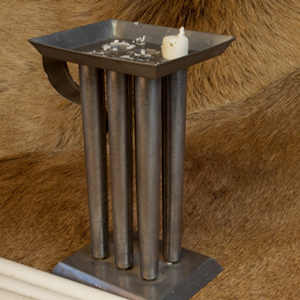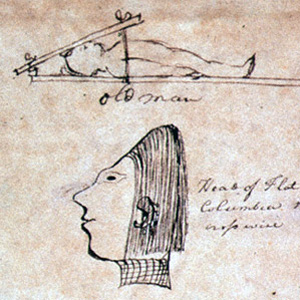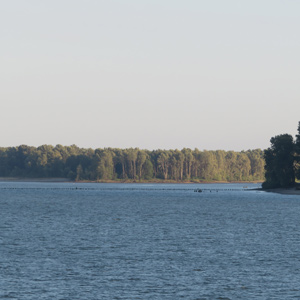Kiscox, A Cowlitz River Chief (1847)
Paul Kane (1810–1871)
Bequest of H.J. Lutcher Stark, 1965, Stark Museum of Art, http://collections.starkculturalvenues.org. Digitally altered for brightness, contrast, levels, curves, and exposure.
The Cowlitz proper were Southwestern Coast Salishan Indians living mainly along the Cowlitz River. The people were blenders. Those living among the Chinookan Skilloots intermarried and may have been indistinguishable when the expedition passed the “Cow-e-lis’-kee” River. To the north, they assimilated with the Upper Chehalis and Taitnapam, a transitory Sahaptin-speaking people. Further changes occurred as the Hudson’s Bay Company maintained Cowlitz Farm to supply Fort Vancouver and Fort Nisqually on Puget Sound. Such was the movement of people and culture through that corridor tht in 1847, Caw-Wacham and baby posed separately for artist Paul Kane becoming the poster mother and child for Chinookan head flattening even though the baby was Cowlitz and Caw-Wacham was Songhee, a tribe then living near the trading company’s fort on Vancouver Island.[1]For more on Caw-Wacham, see on this site, The Wahkiakums.
Clark’s “Cow-e-lis’-kee” is from the Salishan name for the river, káwlic. Moulton speculates that the final “ee” “probably represents the Chinookan locative suffix ‘-i[x]’.” The word káwlicq refers to the people themselves.[2]Yvonne Hadja, Handbook of North American Indians: Northwest Coast Vol. 7, ed. Wayne Suttles (Washington, D.C.: Smithsonian Institution, 1990), 516; Moulton, Journals, 7:21n3.
The Cowlitz were Federally recognized in 2000, but remain the only Federally recognized tribe in Washington State without a reservation.[3]Robert H. Ruby, John A. Brown, and Cary C. Collins, A Guide to the Indian Tribes of the Pacific Northwest (Norman: University of Oklahoma Press, 2010), 114.
Selected Encounters
November 6, 1805
Among the Cowlitz

The men paddle down the Columbia in the rain interacting with several villages near the mouth of the Cowlitz. In the evening, they build large fires to dry out and kill the fleas infesting their blankets.
January 13, 1806
Out of candles

At Fort Clatsop near present Astoria, Oregon, elk tallow is rendered to make new candles, and Lewis finds that elk do not have enough fat. He also describes the ship trade among the area’s Nations.
Chinookan Head Flattening
A most remarkable trait
by Joseph A. Mussulman, Kristopher K. Townsend
The most remarkable trait in the Clatsop Indian physiognomy, Lewis wrote on 19 March 1806, was the flatness and width of their foreheads, which they artificially created by compressing the heads of their infants, particularly girls, between two boards.
March 27, 1806
Generous Skilloots

Near present Deer Island, Oregon, some generous Skilloots give away food with hopes that the expedition hunters will hunt with them. Lewis describes the area’s trees and prepares a salmonberry specimen.
Notes
| ↑1 | For more on Caw-Wacham, see on this site, The Wahkiakums. |
|---|---|
| ↑2 | Yvonne Hadja, Handbook of North American Indians: Northwest Coast Vol. 7, ed. Wayne Suttles (Washington, D.C.: Smithsonian Institution, 1990), 516; Moulton, Journals, 7:21n3. |
| ↑3 | Robert H. Ruby, John A. Brown, and Cary C. Collins, A Guide to the Indian Tribes of the Pacific Northwest (Norman: University of Oklahoma Press, 2010), 114. |
Experience the Lewis and Clark Trail
The Lewis and Clark Trail Experience—our sister site at lewisandclark.travel—connects the world to people and places on the Lewis and Clark Trail.
Discover More
- The Lewis and Clark Expedition: Day by Day by Gary E. Moulton (University of Nebraska Press, 2018). The story in prose, 14 May 1804–23 September 1806.
- The Lewis and Clark Journals: An American Epic of Discovery (abridged) by Gary E. Moulton (University of Nebraska Press, 2003). Selected journal excerpts, 14 May 1804–23 September 1806.
- The Lewis and Clark Journals. by Gary E. Moulton (University of Nebraska Press, 1983–2001). The complete story in 13 volumes.


